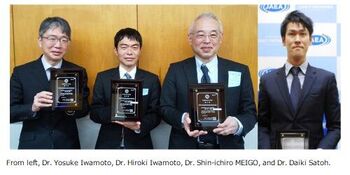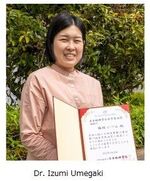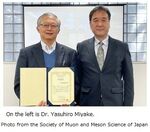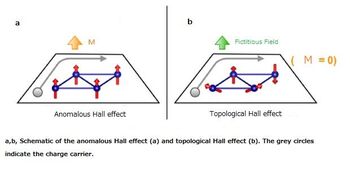J-PARC News May 2023 (Issue #216)
On the Fire in MR Power Supply Building No.2 of J-PARC
At around 17:15 on Tuesday, April 25, 2023,
a fire broke out in Main Ring Power Supply Building No.2 of J-PARC.
The cause of the fire is currently under investigation.
We apologize for any inconvenience this may cause to our users. We appreciate your understanding.
April 28, 2023
Takashi Kobayashi, Director, J-PARC center
■Dr. Hiroki Iwamoto of Nuclear Transmutation Division and Other JAEA Staff Receive Prize of "55th Atomic Energy Society of Japan Article Award"
Dr. Hiroki Iwamoto of the Nuclear Transmutation Division and his collaborators received the prize of "55th Atomic Energy Society of Japan Article Award" on March 14 for the paper on the measurement of spallation neutrons published in the Journal of the Atomic Energy Society of Japan. In this paper, they obtained detailed data on spallation neutrons by impinging with a proton beam into iron (Fe), lead (Pb), and bismuth (Bi) targets, which were important materials in the ADS design, using the Fixed-Field Alternating Gradient proton accelerator at Kyoto University. Based on the obtained data, they validated the accuracy of the nuclear reaction models used in the ADS design and obtained knowledge for the advancement of nuclear reaction models. This achievement and the data obtained in this study are expected to contribute not only to the ADS design but also to the design of many accelerator facilities.
For more information, please visit the JAEA website.
https://nsec.jaea.go.jp/awards/en_index.html
■Dr. Umegaki of Muon Science Section Receives “Young Scientist Award of the Physical Society of Japan”
Dr. Izumi Umegaki of the Muon Science Section received “Young Scientist Award of the Physical Society of Japan”. The title of the award is “Establishment of techniques using muon beam to detect Li diffusion and metallic Li deposition in a Li-ion Battery”. She delivered an award commemorative lecture on March 22 at the Physical Society of Japan 2023 Spring Meeting held online. The award was given based on the evaluation that this research can be applied not only to the field of batteries but also to other fields, and has the potential to develop chemistry beyond physics. For more information, please visit the KEK website.
https://www2.kek.jp/imss/news/2023/topics/0406JPSJ-Wakate-Awd/(only in Japanese)
■Members of Muon Science Section Receive Awards from Society of Muon and Meson Science of Japan
Dr. Yasuhiro Miyake, a member of the Muon Science Section, received the Outstanding Achievement Prize from the Society of Muon and Meson Science of Japan (JMMS). Dr. Miyake successfully led the construction of the world's highest pulsed beam intensity muon beamline at the Materials and Life Science Experimental Facility (MLF) through his strong leadership in the design, establishment of the muon facility, and development of the user experimental environment. In addition to promoting the ultra-slow muon source and transmission muon microscopy research projects, he also focused on the possibility of using the negative muon non-destructive elemental analysis method for cultural heritage research. He devoted himself to building a platform that integrates the humanities and sciences.
At the same time, Mr. Shunsuke Makimura and Dr. Shiro Matoba received the JMMS Technology Prize, and Dr. Junpei Nakamura also received the JMMS Young Researcher Prize.
For more information, please visit the KEK website.
https://www2.kek.jp/imss/news/2023/topics/230426Meson-award/
■Elucidation of Lithium-Ion Transport Environment in Ion-Conducting Glasses
- Pivotal Result for Glass Electrolyte Development with Topological Analysis of Li-Ion Charge Clouds- (April 7)
A research group from Japan Synchrotron Radiation Research Institute, Shimane University, Osaka Metropolitan University, High Energy Accelerator Research Organization (KEK), J-PARC Center, Nagoya Institute of Technology, Yamagata University, University of the Ryukyus, and Tohoku University has successfully elucidated the lithium-ion transport environment in Li3PS4 glasses through high-energy X-ray diffraction using the BL04B2 beamline at SPring-8 and neutron diffraction using BL21 NOVA at J-PARC.
The development and studies on the material properties of sulfide glasses have been conducted worldwide since the 1990s. In the 2010s, materials that exceed the ionic conductivity of liquids at room temperature have been discovered. It is known that the ionic conductivity of sulfide glasses can be improved by partial crystallization, but the reason has not been clarified.
In this study, using the Bader method, which topologically analyzes the valence of Li ions in the sulfide glass Li3PS4, the research team has elucidated that there are three types of Li-ion transport environments and that the more mobile Li ions (Li3-type ions) exhibit a characteristic correlation at relatively long distances. Furthermore, reverse Monte Carlo simulations combined with deep learning potentials showed an increase in the number of Li3-type ions for partially crystallized glass structures with improved Li ion transport properties.
In conventional batteries, electric current is generated by lithium ions moving through the liquid electrolyte between the positive and negative electrodes, but in all-solid-state batteries, which are characterized by a low risk of ignition, long life, large capacity, compact size, and rapid charging, the electrolyte is solid. Therefore, controlling Li-ion transport in glasses at the atomic and molecular levels is key to realizing all-solid-state batteries, a promising technology for electric vehicles. The results of this research will advance the development of new materials and the understanding of the properties of various ion-conducting glasses as well as sulfide glasses and provide a critical direction for the development of solid electrolyte materials.
■Successful Verification of Spontaneous Topological Hall Effect Induced by Non-coplanar Antiferromagnetic Order
- Expected as Promising Material Platform for Reading Out Magnetic Information - (April 21)
A research group from the University of Tokyo, RIKEN, Tohoku University, Toyama Prefectural University, Osaka University, Comprehensive Research Organization for Science and Society (CROSS), Japan Atomic Energy Agency (JAEA), and J-PARC Center has successfully demonstrated the topological Hall effect, a phenomenon in which the direction of electron motion is bent due to the three-dimensional arrangement of spins, in an antiferromagnetic material.
Since the "topological Hall effect" occurs independently of magnetic field and magnetization, it is expected to be utilized as a new probe to read out magnetic information in antiferromagnetic materials. However, previous research has been limited to ferromagnetic materials with large magnetization, and demonstrating the topological Hall effect in antiferromagnets with no net magnetization has been an important challenge.
In this study, the research team focused on the materials CoTa3S6 and CoNb3S6, which are known to host spontaneous Hall effect despite their negligibly small net magnetization, and performed detailed magnetic structure analyses by neutron scattering experiments using 5G PONTA installed in the research reactor JRR-3, and BL15 TAIKAN and BL18 SENJU of the Materials and Life Science Facility in J-PARC. As a result, it was found that a tetrahedral non-coplanar spin arrangement, which was theoretically predicted to induce the topological Hall effect, was realized. Furthermore, the stability of this spin arrangement was theoretically confirmed.
The results of this research are expected to lead to the development of new high-speed, high-density magnetic information devices based on antiferromagnetic materials.
The normal Hall effect in ferromagnets with magnetization and the topological Hall effect in antiferromagnets without magnetization. On the left, magnetization and on the right, the virtual magnetic field due to the three-dimensional spin arrangement cause the electron (gray circle) to bend its direction of motion, respectively. The red arrows indicate the spin direction.
■3rd International Workshop on Hadron Facility Expansion Project (March 14-16, Venue: AQBRC, KEK Tokai 1st Building and online)
The workshop consisted of a plenary session and three parallel sessions on hadron physics, strangeness nuclear physics, and flavor physics, the main research areas at the J-PARC Hadron Experimental Facility (HEF). Eighty-nine talks were presented, discussing the extension project of HEF and the latest state of physics research, both experimental and theoretical aspects. The research at the current and future facilities was discussed lively and widely. Of the 188 registered participants, 59 were from foreign institutions, about 60 were present in person, and ten came from overseas. To have so many researchers participating and discussing face-to-face in a full-fledged international workshop after the corona was a great achievement. The continuous discussions on the extension project of HEF gave the impression that much research is being actively pursued in both experimental and theoretical fields.
■J-PARC Hello Science "Development of Superconducting Accelerating Cavity @ J-PARC" (March 24)
Dr. Jun Tamura of Accelerator Section I, concurrently in charge of the Nuclear Transmutation Division, lectured on the development of superconducting (SC) radio-frequency (rf) cavities necessary to realize the SC proton linac for the Accelerator Driven subcritical System (ADS) for the transmutation of nuclear waste.
First, he explained the principle of particle acceleration in the J-PARC linac and the basic features of rf cavities, followed by a comparison of a normal-conducting (NC) cavity and an SC cavity. In the NC cavities, most of the input power is dissipated in the inner wall of the cavity, which makes continuous beam operation using a high gradient electric field impractical. On the other hand, in the SC cavities, the dissipation power (heat consumption) is 5 to 6 orders of magnitude less than in the NC cavities. This means that the SC cavities can generate a high gradient electric field with very little power consumption, which enables not only pulsed beam operation but also continuous beam operation. Therefore, a practical-scale ADS accelerator requires an SC proton linac capable of continuous beam operation with a high gradient electric field.
Finally, he explained the development status of the prototype spoke cavity, introducing the actual cavity components. The spoke cavity is one of the SC cavities and is more suitable for accelerating low-energy proton beams than elliptical SC cavities. Design and fabrication of the spoke cavity began in 2019, and the cavity assembly is currently in progress using electron beam welding. He introduced the plan to proceed to the performance test of the prototyped cavity after surface treatment, heat treatment, and high-pressure rinsing. Because the spoke cavity has a complex configuration and the “manufacturing” to make it work as an accelerating cavity is challenging, the establishment of cavity fabrication processes and its performance evaluation are essential subjects.
■Announcement of "J-PARC Special Lecture 2023" (July 1, Tokai Culture Center)
On July 1, J-PARC Special Lecture 2023, "The Hyper-Kamiokande Project Finally Begins," will be held at the Tokai Culture Center with Prof. Takaaki Kajita, 2015 Nobel Laureate in Physics.
Please click here for details.
http://j-parc.jp/symposium/special_lecture2023/
■Sanpo-michi#34 Minano River
The Minano River
Falling down from the peak of Mount Tsukuba,
My love piles up and becomes a deep pool.
The photo shows Mt. Tsukuba from a bus window between Tsukuba and Tokai. As you can see, Mt. Tsukuba, a famous mountain in Ibaraki Prefecture and one of the 100 most famous mountains of Japan, consists of two peaks, the Nantaisan and the Nyotaisan.
This poem, which is on the 13th in the Hyakunin Isshu (100 poems by 100 famous poets), is said to have been written by the 57th emperor, Yozeiin, to Princess Suishi. The poem expresses the feeling that his love, which was faint at first, was becoming deeper and deeper, just as the slender streams originating from the Nantaisan and Nyotaisan merge to form the Minano River, which gradually rises to turn a deep abyss.
J-PARC is a gigantic research project that was born from two completely different corporations, JAEA, which is headquartered in the north from Mount Tsukuba, and KEK, which is headquartered in the south. At the beginning of J-PARC, there were many times when the two organizations were bewildered each other as if rushing currents from two peaks were colliding. However, as we aim to make a broad contribution to humanity by promoting research and development in various fields, from basic science to industrial applications, with highly accelerated proton beams, we need to cooperate in operating facilities and conducting experiments.
This was indicated during the Great East Japan Earthquake of 2011. The equipment in the accelerator tunnel was submerged underwater, and it was feared that recovery would be impossible. But the staff worked together and resumed operations less than a year after the disaster.
Just as a drop of water that comes out of the ground eventually flows into the ocean, the negative hydrogen ions produced in the linac ion source flow downstream in the river created by JAEA and KEK. The negative hydrogen ions become protons at the entrance to the RCS, collide with the target, and are transformed into various secondary particles that then embark on the long journey to Super-Kamiokande.







